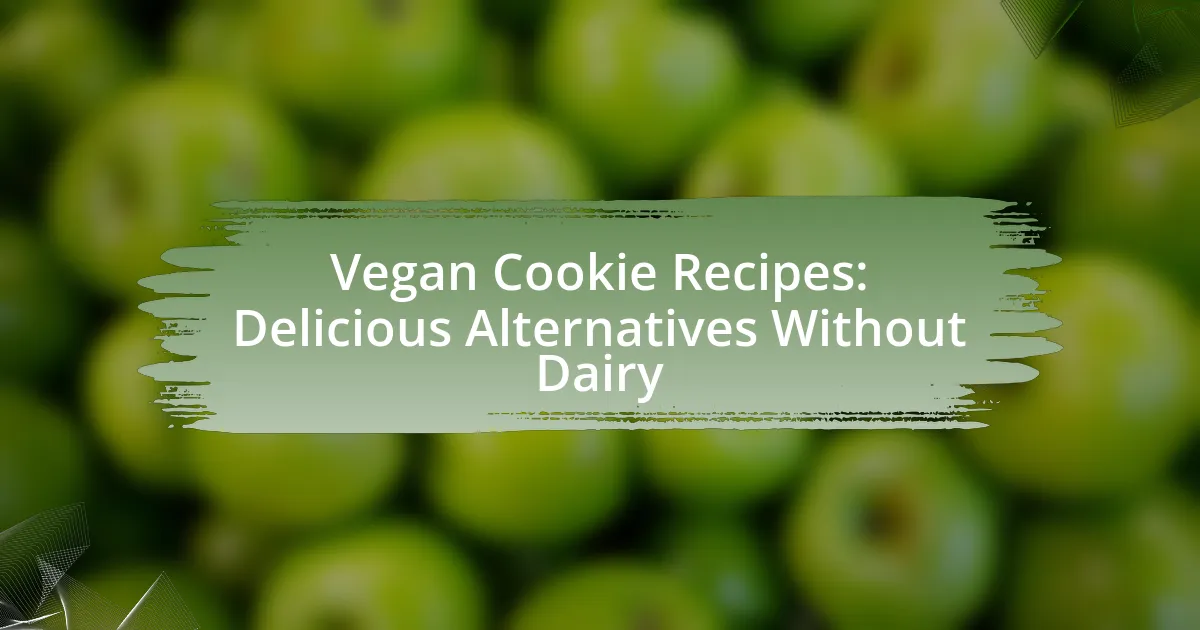The article focuses on the critical roles of butter, sugar, and flour in cookie recipes, detailing how each ingredient contributes to the texture, flavor, and structure of cookies. It explains the specific functions of butter in providing moisture and richness, the impact of sugar on sweetness and browning, and the importance of flour in creating structure. Additionally, the article discusses the significance of ingredient ratios, the effects of different types of sugars and flours, and best practices for measuring and substituting ingredients to achieve optimal cookie outcomes. Understanding these elements is essential for successful cookie baking and achieving desired results.

What is the role of ingredients in cookie recipes?
Ingredients in cookie recipes serve specific functions that contribute to the texture, flavor, and overall structure of the cookies. For instance, flour provides the necessary structure and stability, while sugar not only sweetens but also affects the spread and texture by influencing moisture retention. Butter adds richness and flavor, and it plays a crucial role in creating a tender crumb through its fat content. Each ingredient interacts with others, such as how baking soda or baking powder acts as a leavening agent, creating a light and airy texture. These roles are essential for achieving the desired outcome in cookie baking, as evidenced by the science of baking which shows that the balance and interaction of these ingredients determine the final product’s quality.
How do butter, sugar, and flour contribute to cookie texture and flavor?
Butter, sugar, and flour are essential ingredients that significantly influence cookie texture and flavor. Butter provides richness and moisture, contributing to a tender and chewy texture due to its fat content, which coats flour proteins and inhibits gluten formation. Sugar not only sweetens cookies but also affects texture; it creates a crisp exterior and helps retain moisture, leading to a softer interior. Flour, primarily composed of gluten-forming proteins, gives structure to cookies; the type of flour used can alter the final texture, with all-purpose flour yielding a balanced cookie and cake flour producing a softer, more delicate result. Together, these ingredients interact to create the desired balance of flavor and texture in cookies.
What specific functions does butter serve in cookie recipes?
Butter serves multiple specific functions in cookie recipes, including providing moisture, contributing to flavor, and affecting texture. The moisture from butter helps to hydrate the dry ingredients, ensuring a cohesive dough. Additionally, the fat in butter enhances the flavor profile of cookies, making them richer and more appealing. Furthermore, butter influences the texture by creating a tender crumb and promoting a desirable chewiness, which is essential for many cookie varieties. These functions are supported by the fact that cookies made with butter typically have a more complex flavor and a softer texture compared to those made with alternative fats.
How does sugar influence the sweetness and browning of cookies?
Sugar directly influences the sweetness and browning of cookies by providing sweetness through its chemical composition and facilitating the Maillard reaction during baking. The presence of sugar enhances the overall flavor profile, making cookies taste sweeter, while also contributing to the browning effect as it caramelizes at high temperatures. This caramelization occurs when sugar is heated, leading to the development of complex flavors and a golden-brown color, which is essential for the appealing appearance of baked cookies. The Maillard reaction, which occurs between sugars and amino acids, further enhances browning and flavor complexity, resulting in a desirable texture and taste.
What role does flour play in the structure of cookies?
Flour is essential for providing structure to cookies. It contains proteins, primarily glutenin and gliadin, which form gluten when mixed with water. This gluten network gives cookies their shape and chewiness, allowing them to hold together during baking. The amount and type of flour used can significantly affect the texture; for instance, all-purpose flour creates a balanced structure, while cake flour results in a softer cookie due to its lower protein content.
Why is the balance of these ingredients important?
The balance of butter, sugar, and flour in cookie recipes is crucial because it directly affects the texture, flavor, and overall quality of the cookies. Each ingredient plays a specific role: butter provides moisture and richness, sugar contributes sweetness and aids in browning, while flour gives structure. An imbalance can lead to cookies that are either too dry, too dense, or lacking in flavor. For instance, a higher ratio of flour can result in a tough texture, while too much sugar can cause excessive spreading and a overly sweet taste. Therefore, precise measurements ensure that the cookies achieve the desired characteristics, as supported by baking science which emphasizes the importance of ingredient ratios in achieving optimal results.
How does the ratio of butter, sugar, and flour affect cookie outcomes?
The ratio of butter, sugar, and flour significantly influences cookie outcomes, affecting texture, flavor, and spread. A higher butter ratio typically results in a softer, chewier cookie due to increased fat content, which creates a tender crumb. Conversely, a higher flour ratio leads to a denser, cake-like texture, as flour provides structure. The sugar ratio also plays a crucial role; more sugar can enhance spread and caramelization, while less sugar may yield a thicker cookie. Research indicates that a balanced ratio of these ingredients is essential for achieving the desired cookie characteristics, as demonstrated in studies on baking chemistry, which show that variations in these ratios can alter moisture retention and overall cookie quality.
What happens if one ingredient is altered in a cookie recipe?
Altering one ingredient in a cookie recipe can significantly change the texture, flavor, and overall outcome of the cookies. For instance, if the amount of sugar is reduced, the cookies may turn out less sweet and could have a drier texture due to less moisture retention. Conversely, increasing the sugar can lead to a chewier cookie because sugar contributes to moisture and caramelization during baking. Similarly, changing the type of flour affects the gluten development; using cake flour instead of all-purpose flour results in a softer, more tender cookie due to lower protein content. Each ingredient plays a crucial role in the chemical reactions during baking, which ultimately determines the final product’s characteristics.

What types of butter are best for cookie recipes?
The best types of butter for cookie recipes are unsalted butter and European-style butter. Unsalted butter allows for better control of the salt content in the recipe, which is crucial for achieving the desired flavor balance. European-style butter typically has a higher fat content, around 82% compared to the 80% found in standard butter, resulting in richer flavor and improved texture in cookies. This higher fat content contributes to a tender crumb and enhanced moisture retention, making cookies softer and chewier.
How does salted vs. unsalted butter impact cookie flavor?
Salted butter enhances cookie flavor by adding a savory element that balances sweetness, while unsalted butter allows for more precise control over the overall salt content in the recipe. The presence of salt in salted butter can intensify flavors and create a more complex taste profile, as it interacts with the sugars and other ingredients during baking. Conversely, unsalted butter provides a neutral base, enabling bakers to adjust the salt level according to their preference, which can lead to a more tailored flavor experience. This distinction is crucial, as many professional bakers recommend using unsalted butter for consistency and to ensure the desired flavor balance in cookies.
What are the benefits of using different types of butter in baking?
Using different types of butter in baking enhances flavor, texture, and moisture content in baked goods. For instance, unsalted butter allows for precise control over salt levels, while salted butter can add a savory depth to cookies. Additionally, European-style butter, which has a higher fat content, contributes to a richer flavor and a more tender crumb. Clarified butter, with its milk solids removed, can increase the shelf life of baked products and provide a nutty flavor. Each type of butter brings unique properties that can significantly impact the final outcome of baked goods, making the choice of butter crucial for achieving desired results.
How does the temperature of butter affect cookie dough?
The temperature of butter significantly affects the texture and spread of cookie dough. When butter is at room temperature, it incorporates air more effectively during creaming, resulting in a lighter and fluffier cookie. Conversely, using cold butter leads to denser cookies with less spread, as the fat does not emulsify properly with the sugar. Research indicates that the ideal temperature for butter in cookie recipes is around 65°F (18°C) for optimal performance, as this allows for the right balance of aeration and fat distribution, impacting the final cookie’s structure and mouthfeel.
What alternatives exist for butter in cookie recipes?
Vegetable oil serves as a primary alternative to butter in cookie recipes, providing similar moisture and fat content. Additionally, coconut oil can be used, offering a distinct flavor and texture while maintaining the necessary fat for baking. Applesauce is another option, particularly for healthier recipes, as it adds moisture and sweetness with fewer calories. Lastly, margarine can replace butter directly in equal amounts, though it may alter the flavor slightly. These alternatives maintain the essential characteristics needed for successful cookie baking.
How do margarine and oils compare to butter in cookies?
Margarine and oils generally produce cookies that are softer and chewier compared to those made with butter, which tends to create a firmer texture. This difference arises because butter contains about 80% fat and 20% water, while margarine and oils are typically 100% fat, leading to variations in moisture content and texture. Additionally, butter contributes a distinct flavor due to its milk solids, whereas margarine and oils may lack this richness, affecting the overall taste of the cookies. Studies indicate that cookies made with margarine can spread more during baking, resulting in thinner cookies, while those made with butter maintain their shape better.
What are the effects of using vegan butter substitutes?
Using vegan butter substitutes can lead to changes in texture, flavor, and nutritional profile in cookie recipes. These substitutes often contain oils, starches, and emulsifiers, which can result in cookies that are softer or denser compared to those made with traditional butter. For instance, a study published in the Journal of Food Science found that cookies made with margarine, a common vegan butter substitute, had a lower spread and a firmer texture than those made with dairy butter. Additionally, vegan butter substitutes typically have lower saturated fat content, which can contribute to a healthier nutritional profile, but may also affect the richness and flavor of the final product.

What types of sugar are commonly used in cookie recipes?
Commonly used types of sugar in cookie recipes include granulated sugar, brown sugar, and powdered sugar. Granulated sugar provides sweetness and contributes to the cookie’s structure, while brown sugar adds moisture and a rich flavor due to its molasses content. Powdered sugar, also known as confectioners’ sugar, is often used for icing or dusting cookies, providing a smooth texture. These sugars play distinct roles in achieving the desired taste and texture in cookies, making them essential ingredients in various recipes.
How do granulated, brown, and powdered sugar differ in cookies?
Granulated, brown, and powdered sugar differ in cookies primarily in their texture, moisture content, and flavor impact. Granulated sugar contributes to a crisp texture and helps cookies spread, while brown sugar, which contains molasses, adds moisture and a chewy texture, enhancing the flavor with caramel notes. Powdered sugar, being finely ground, is often used for icing or dusting rather than in the dough itself, resulting in a softer, less structured cookie. These differences affect the final product’s taste and texture, as evidenced by recipes that specify sugar types to achieve desired outcomes in cookies.
What impact does brown sugar have on cookie moisture and chewiness?
Brown sugar significantly increases cookie moisture and chewiness due to its higher molasses content compared to white sugar. The presence of molasses not only adds moisture but also contributes to a denser texture, resulting in chewier cookies. Research indicates that the hygroscopic nature of brown sugar allows it to retain moisture during baking, which enhances the overall softness and chewiness of the final product.
How does the choice of sugar affect the spread of cookies?
The choice of sugar significantly affects the spread of cookies, with different types of sugar influencing texture and shape. Granulated sugar promotes more spread due to its ability to dissolve quickly and create a thinner batter, while brown sugar, which contains molasses, retains moisture and results in a thicker, chewier cookie. Research indicates that cookies made with a higher proportion of brown sugar spread less than those made with granulated sugar, as the moisture content in brown sugar affects the dough’s consistency and baking behavior.
What are the effects of using sugar substitutes in cookies?
Using sugar substitutes in cookies can significantly alter their texture, flavor, and nutritional profile. Sugar substitutes, such as stevia or erythritol, often result in cookies that are lower in calories and carbohydrates compared to those made with traditional sugar. However, these substitutes can also lead to a drier texture and may not provide the same browning or spreading properties during baking, which are essential for achieving the desired cookie consistency. Research indicates that the use of sugar substitutes can affect the overall taste, with some consumers reporting a distinct aftertaste associated with certain sweeteners. Additionally, the chemical properties of sugar substitutes differ from those of sugar, impacting the cookie’s moisture retention and shelf life.
How do artificial sweeteners change the texture and taste of cookies?
Artificial sweeteners alter the texture and taste of cookies by affecting moisture retention and sweetness perception. Unlike traditional sugars, which contribute to browning and a chewy texture through caramelization and hygroscopic properties, artificial sweeteners often lack these qualities. For example, erythritol, a common artificial sweetener, can lead to a drier cookie due to its lower moisture retention compared to sugar. Additionally, the taste profile can be impacted; some artificial sweeteners may impart a bitter or metallic aftertaste, which can detract from the overall flavor experience of the cookie. Studies have shown that cookies made with artificial sweeteners can have a different mouthfeel and sweetness intensity, leading to a less satisfying eating experience compared to those made with regular sugar.
What are the best practices for substituting sugar in cookie recipes?
The best practices for substituting sugar in cookie recipes include using alternatives like honey, maple syrup, or coconut sugar, while adjusting the liquid content and baking time accordingly. Honey and maple syrup are liquid sweeteners, so for every cup of sugar replaced, reduce the liquid in the recipe by about 1/4 cup and lower the oven temperature by 25°F to prevent over-browning. Coconut sugar can be used in a 1:1 ratio, as it has a similar texture and sweetness level to granulated sugar. These substitutions not only maintain the cookie’s structure but also enhance flavor profiles, as supported by culinary studies that highlight the impact of different sweeteners on baking outcomes.

What types of flour are best for cookie recipes?
All-purpose flour and bread flour are the best types of flour for cookie recipes. All-purpose flour provides a balanced protein content, typically around 10-12%, which yields a tender and chewy texture in cookies. Bread flour, with a higher protein content of about 12-14%, can create a denser and chewier cookie, making it ideal for certain recipes like chocolate chip cookies. The protein content in these flours contributes to gluten formation, which affects the structure and texture of the final product.
How does all-purpose flour compare to specialty flours in cookies?
All-purpose flour provides a balanced structure and texture in cookies, while specialty flours, such as almond or whole wheat, can alter the flavor, density, and nutritional profile. All-purpose flour typically contains a moderate protein content (around 10-12%), which contributes to a chewy texture and allows for good spread during baking. In contrast, specialty flours may have higher protein or fat content, affecting the cookie’s final outcome; for example, almond flour adds moisture and a nutty flavor but can lead to denser cookies. The choice between all-purpose and specialty flours ultimately depends on the desired cookie characteristics, with all-purpose flour being the most versatile option for standard cookie recipes.
What is the significance of gluten content in cookie flour choices?
The significance of gluten content in cookie flour choices lies in its impact on the texture and structure of the cookies. Higher gluten content, typically found in bread flour, results in chewier cookies due to increased elasticity, while lower gluten content, found in cake flour, leads to softer, more tender cookies. Research indicates that all-purpose flour, which has moderate gluten content, is often preferred for cookies as it balances chewiness and tenderness, providing a desirable texture for most cookie recipes.
How do whole wheat and gluten-free flours affect cookie texture?
Whole wheat flour and gluten-free flours significantly influence cookie texture. Whole wheat flour contains bran and germ, which contribute to a denser, chewier texture due to increased fiber content and reduced gluten formation compared to all-purpose flour. In contrast, gluten-free flours, such as almond or rice flour, often result in a crumbly or gritty texture because they lack gluten, which provides structure and elasticity in baked goods. Studies indicate that cookies made with gluten-free flours may require additional binding agents, like xanthan gum, to improve texture and mimic the chewiness provided by gluten.
What are the best practices for measuring flour in cookie recipes?
The best practices for measuring flour in cookie recipes include using the spoon-and-level method, which involves spooning flour into a measuring cup and leveling it off with a straight edge. This technique prevents packing, which can lead to excess flour and dry cookies. Additionally, using a kitchen scale to measure flour by weight is recommended, as it provides the most accurate measurement; one cup of all-purpose flour typically weighs around 120 grams. Accurate measurement is crucial because variations can significantly affect the texture and structure of cookies, as supported by baking science that emphasizes the importance of precise ingredient ratios for optimal results.
How does the method of measuring flour impact cookie results?
The method of measuring flour significantly impacts cookie results by affecting the flour’s density and, consequently, the cookie’s texture and structure. When flour is scooped directly from the bag, it can become compacted, leading to an excess amount of flour in the recipe, which results in dry and crumbly cookies. Conversely, spooning flour into a measuring cup and leveling it off provides a more accurate measurement, yielding cookies that are tender and chewy. Studies have shown that precise measurements are crucial in baking; for instance, the King Arthur Baking Company emphasizes that a difference of just a few grams can alter the final product’s quality. Therefore, the method of measuring flour directly influences the balance of ingredients, affecting the overall outcome of the cookies.
What tips can ensure accurate flour measurement for consistent cookies?
To ensure accurate flour measurement for consistent cookies, use the spoon-and-level method. This involves spooning flour into a measuring cup and leveling it off with a straight edge, preventing compaction that can lead to excess flour. Studies show that a cup of flour can weigh between 120 to 130 grams depending on how it is measured, which significantly affects the final cookie texture. Additionally, using a kitchen scale for weighing flour provides the most precise measurement, as it eliminates variability caused by different measuring techniques.
What are some common troubleshooting tips for cookie recipes?
Common troubleshooting tips for cookie recipes include adjusting ingredient ratios, checking oven temperature, and ensuring proper mixing techniques. For instance, if cookies spread too much, reducing the butter or increasing the flour can help achieve the desired thickness. If cookies are too dry, adding a bit more butter or an egg can improve moisture. Additionally, using an oven thermometer can verify that the baking temperature is accurate, as an incorrect temperature can lead to underbaking or overbaking. Properly creaming butter and sugar until light and fluffy ensures a good texture, while overmixing can lead to tough cookies. These adjustments are based on the fundamental roles of butter, sugar, and flour in cookie recipes, which directly influence the final product’s texture and flavor.
How can ingredient adjustments solve common cookie baking issues?
Ingredient adjustments can effectively solve common cookie baking issues by altering the ratios and types of butter, sugar, and flour used in the recipe. For instance, increasing the flour can prevent cookies from spreading too much, while reducing sugar can help achieve a firmer texture. Additionally, substituting butter with a higher fat content can enhance moisture and richness, addressing dryness. These adjustments are supported by baking science, which indicates that the balance of ingredients directly influences the final product’s texture and flavor.
What are the best practices for achieving the perfect cookie texture?
To achieve the perfect cookie texture, it is essential to balance the ratios of butter, sugar, and flour. Using a higher butter content results in a chewier texture, while a lower amount leads to a crisper cookie. The type of sugar also influences texture; granulated sugar creates a crispier cookie, whereas brown sugar adds moisture and chewiness due to its molasses content. Additionally, using all-purpose flour provides a good structure, while cake flour can yield a softer texture.
Baking at the right temperature is crucial; a higher temperature promotes spreading and crispiness, while a lower temperature allows for a thicker, softer cookie. Resting the dough before baking enhances flavor and texture by allowing the flour to hydrate fully and the sugars to dissolve. These practices are supported by baking science, which shows that ingredient ratios and baking conditions directly affect the final cookie outcome.




